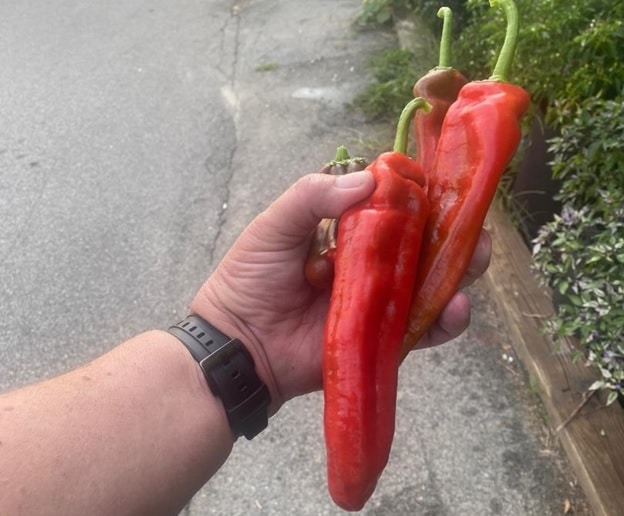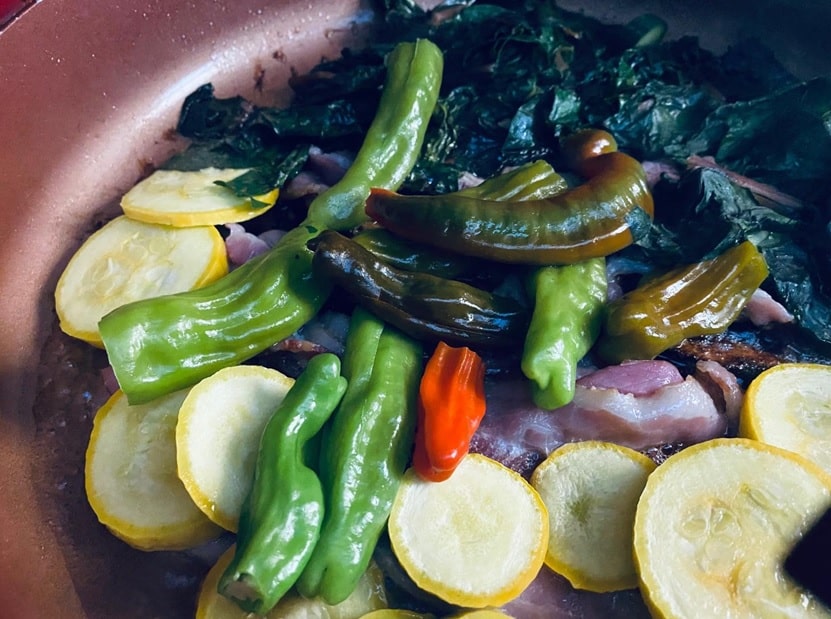I am going to take a lot of heat for this.
But my mom was not a good cook. There, I said it. I love her dearly but my culinary upbringing would constitute child abuse in the 2020s. In order to keep us untouched by the multitudes of microbes in the world, vegetables were cooked until they were a mushy slop and meats had every last bit of moisture driven from them. Seasonings were nonexistent unless you count salt and whatever finely ground black pepper was on sale. Imagine the horror of liver and onions night.
In the decades that have passed since that culinary dark age, I have discovered many cuisines, the seasonings that go with them, and the joy of fresh organic foods. I admit a special fondness for either growing the food myself or shopping at a local farmers market. I am blessed with a green thumb but growing does not have the adventure and possibility of discovery that you get at a farmer’s market. The local farmer’s market is always one of my stops when I am on the road for work or pleasure.
Twenty years ago, I found myself exploring a farmers market in the Dallas/Fort Worth area. I was assured that we were still in the Dallas/Ft. Worth metro area but it seemed like we were at least an hour south and on a so-called farm-to-market road. If I had been on my own, I would have said I was lost, but I was lucky enough to have an experienced local shopper as my guide. We pulled into a lot with a huge hand-painted Farmers Market sign. Maybe about a dozen vendors and piles of fresh produce, meats and even a fireworks vendor. I guessed that this was not an “officially sanctioned” event. There were plenty of customers considering that it was mid afternoon and it was blisteringly hot.
I am always on the lookout for farm fresh meats and ended up following my nose to a heavily patinated pickup truck offering grilled chorizo sausage. I was not familiar with chorizo and I inquired about the ingredients. I was told that there were only two: feral hog and dried jalapeños. The five-alarm bells went off. Do you think I was concerned about the wild meat that almost certainly had not passed any USDA inspections? Not a bit, but of all the foods I had tried, chile peppers were by far guilty of provoking the most adverse reactions. I had flashbacks to my friend’s special homemade chili, as well as an innocent-looking green sauce I once encountered in a Mexican restaurant. Each time, my taste buds were immobilized with the first bite. So I tended to avoid foods with detectable levels of chile peppers.
My guide, a native Texan, was giving me “the look.” Too embarassed to resist, I ordered a fresh grilled link. The chorizo was wrapped in nothing but a paper towel. I took it in hand and took a big bite. The first flavor rush was that of the pork, ever so slightly gamey and much leaner, but even more heavenly than the free-range acorn-fed pork I was getting at the farmers markets in my native New England. This was followed by a slightly smoky flavor with a bright chlorophyll hint, and then the heat. Instead of my tongue reporting a flambe was being prepared in my mouth, there was a glow of heat that added to and complemented the flavor. The heat grew and glowed, my face flushed. Quite warm but quite pleasant, a transformative experience. After following it with a cooling flan, the best I have even eaten, I went back and purchased five pounds of the chorizo. That one pork link started me down the path of chile pepper appreciation — or maybe you would call it madness.
On any given day, a quarter of the world’s population will eat chile peppers. Over 80 million tons of them are consumed every year, and I dare say I help. If you believe everything you read on the internet, chiles are a true superfood. Chiles do have solid nutritional value, but I leave the reader to search through the claims on the web and judge for yourselves. Use them in your cooking for the flavor and the heat. It will feed your soul.

I have a creation that I call everyday pepper sauce. It is quite hot if eaten alone but is meant to be used as a side sauce or as an ingredient in your recipes. I make it as a way to preserve my crop and to make it easy to experiment with.

First gather the ingredients. All peppers are best fresh from the garden or farmer’s market. Get about fifteen to twenty habanero peppers; about 4 ounces, and the same weight in sweet peppers as well. Try to find something other than bell peppers. Bell peppers have been bred to grow fast in a shape that is efficient to pack in a box. Along the way, flavor has taken a back seat. I recommend poblano, cubanelle, shishito or Anaheim peppers. Certainly, this is not an option for everyone or at all times. Habaneros are generally available in supermarkets. Sweet peppers are more challenging since the bell pepper juggernaut dominates, but with a little searching you will find them available.
You will need about 227 grams (1/2 pound) of sauce tomatoes. Roma tomatoes work and are easy to find. If you have to use salad tomatoes, up the quantity to 340 grams (3/4 pound) and use 60 ml (1/4 cup) less water in the recipe.
Last, you will need 120 ml (1/2 cup) of key lime juice. If you do not have key lime juice, use apple cider vinegar.
To prepare the peppers, remove the stems and coarsely chop the peppers. I highly recommend rubber gloves for handling the hot peppers. If you handle hot peppers often you will be okay with the heat on your hands, but if you inadvertently touch other, more sensitive, body parts, you may be in for an uncomfortable ride. I have experienced habanero eyes more than once and it lasts for hours.

Prepare the tomatoes the same way. You may have noticed that I did not have you remove the skin or seeds. It is much work and they will be strained out after cooking.

Put the tomatoes and peppers in a saucepan, add the key lime juice and 120 ml (1/2 cup) water. The liquid should just cover the vegetables; if it does not, add a little more water.
Bring the saucepan to a boil and reduce heat to a low simmer. Optional at the point is to add 5 ml (1 teaspoon) of sea salt. Simmer, uncovered, for 30 minutes, adding more water if needed.
Simmer for one half hour, stirring occasionally. Let cool for a half hour, pour the mixture into a blender and run on liquify for one full minute. Rinse the saucepan, then strain the mixture back into the saucepan. Simmer until the resulting sauce is about the consistency of tomato juice. Your sauce will last four weeks if refrigerated, or over six months if you freeze it between uses. Add it to pasta and pizza sauce to bring them to life. Mix it with mayonnaise and sour cream for an interesting salad dressing. Or use it anywhere you might use hot sauce. I am currently experimenting with adding it to my corn bread mix, but that still needs work. Let your imagination run wild. Share it with friends, but remember, it is not a contest to see whose tongue can take the most heat, but rather a way of adding the magic to their lives. ![]()
